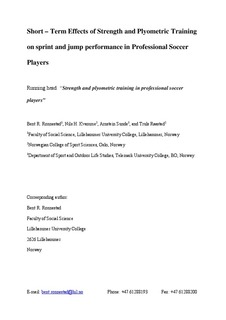| dc.contributor.author | Rønnestad, Bent R. | |
| dc.contributor.author | Kvamme, Nils Helge | |
| dc.contributor.author | Sunde, Arnstein | |
| dc.contributor.author | Raastad, Truls | |
| dc.date.accessioned | 2009-08-13T12:56:24Z | |
| dc.date.issued | 2008-05 | |
| dc.identifier | Seksjon for fysisk prestasjonsevne / Department of Physical Performance | |
| dc.identifier.citation | Journal of Strength and Conditioning Research. 2008, 22(3), 773-780 | en |
| dc.identifier.issn | 1064-8011 | |
| dc.identifier.uri | http://hdl.handle.net/11250/170477 | |
| dc.description | I Brage finner du siste tekst-versjon av artikkelen, og den kan inneholde ubetydelige forskjeller fra forlagets pdf-versjon. Forlagets pdf-versjon finner du på http://dx.doi.org/10.1519/JSC.0b013e31816a5e86 / In Brage you'll find the final text version of the article, and it may contain insignificant differences from the journal's pdf version. The original publication is available at http://dx.doi.org/10.1519/JSC.0b013e31816a5e86 | en |
| dc.description.abstract | The purpose of this study was to compare the effects of combined strength and plyometric training with strength training alone on power-related measurements in professional soccer players. Subjects in the intervention team were randomly divided into 2 groups. Group ST (n = 6) performed heavy strength training twice a week for 7 weeks in addition to 6 to 8 soccer sessions a week. Group ST+P (n = 8) performed a plyometric training program in addition to the same training as the ST group. The control group (n = 7) performed 6 to 8 soccer sessions a week. Pretests and posttests were 1 repetition maximum (1RM) half squat, countermovement jump (CMJ), squat jump (SJ), 4-bounce test (4BT), peak power in half squat with 20 kg, 35 kg, and 50 kg (PP20, PP35, and PP50, respectively), sprint acceleration, peak sprint velocity, and total time on 40-m sprint. There were no significant differences between the ST+P group and ST group. Thus, the groups were pooled into 1 intervention group. The intervention group significantly improved in all measurements except CMJ, while the control group showed significant improvements only in PP20. There was a significant difference in relative improvement between the intervention group and control group in 1RM half squat, 4BT, and SJ. However, a significant difference between groups was not observed in PP20, PP35, sprint acceleration, peak sprinting velocity, and total time on 40-m sprint. The results suggest that there are no significant performance-enhancing effects of combining strength and plyometric training in professional soccer players concurrently performing 6 to 8 soccer sessions a week compared to strength training alone. However, heavy strength training leads to significant gains in strength and power-related measurements in professional soccer players. | en |
| dc.format.extent | 157257 bytes | |
| dc.format.mimetype | application/pdf | |
| dc.language.iso | eng | en |
| dc.publisher | NSCA | en |
| dc.subject | combined training | en |
| dc.subject | running speed | en |
| dc.subject | one repetition maximum half squat | en |
| dc.subject | squat jump | en |
| dc.subject | power | en |
| dc.title | Short-term effects of strength and plyometric training on sprint and jump performance in professional soccer players | en |
| dc.type | Peer reviewed | en |
| dc.type | Journal article | en |
| dc.subject.nsi | VDP::Social science: 200::Social science in sports: 330::Other subjects within physical education: 339 | en |
| dc.source.pagenumber | 773-780 | en |
| dc.source.volume | 22 | en |
| dc.source.journal | Journal of Strength and Conditioning Research | en |
| dc.source.issue | 3 | en |
